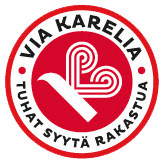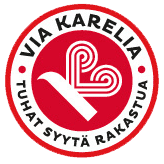Archives: Kunnat
Ilomantsi is known for its happy people, as well as its location as the easternmost continental municipality in Finland and in the EU. Ilomantsi has many sites of military history, and our national epic Kalevala comes alive here. The Orthodox faith is very prominent in Ilomantsi. The region is known for wilderness, apex predators and…
The red and black featured in the coat of arms are typical of Karelia. The wave motif refers to the Pielisjoki river, and the embattled line to the town’s position near the eastern frontier. Joensuu is the centre of the region of North Karelia, located on the norther shore of lake Pyhäselkä, at the mouth…
The helm in the coat of arms refers to the first Finnish steam boat, Ilmarinen, launched in Puhos, Kitee in 1833. The area has had permanent inhabitants as early as in the 15th century. There are many marked nature trails, where you can get a good idea of the local nature: groves, ridges, lakes, and…
The coat of arms of the municipality has a peasant drawing a bow. This motif originates from a signet of the town of Brahea, from 1669. Lieksa was later built on the same site. Lieksa is located between Lake Pielinen and the Russian frontier. The main attractions are Koli and Ruunaa rapids. The peaks of…
The bear hunting spear heads in the coat of arms refer to old hunting practices, and to the peasant soldier Olli Tiainen, who went against persecutors. Nurmes is surrounded by vast, forested hills and the northern part of Lake Pielinen. On the outskirts of the town, the Bomba house and Karelian village show the many…
The Tohmajärvi coat of arms has an anvil and a red flame, symbolising the old iron industry in the region. The municipality is characterised by forested hills and large mires. The grove zone of Lake Ladoga is very lush and impressive. The main cultural attraction is the region’s oldest wooden church in Kirkkoniemi, dating back…
Valtimo’s coat of arms has a wolf in upright position and seven gold coins. These refer to local folklore of Simo Hurtta and his brutal ways of collecting taxes. The northernmost municipality in North Karelia is characterised by vast farmlands and wilderness, where the rugged peaks can be as high as 300 metres. Valtimo is…
The three golden spruces in the coat of arms refer to wilderness typical of the municipality of Kuhmo. Kuhmo has a famous annual chamber music festival. Kuhmo is the largest municipality in Europe by area, and bears and other apex predators are abundant in the coniferous forests, or taiga. Kuhmo as many nature activities and…
The four burning splints, used as a source of light in the olden times, symbolise the four base houses, mentioned in documents dating back to 1604. As evidenced by hundreds of Stone Age living sites and rock paintings on Värikallio, in the Hossa National Park, the region has been inhabited for thousands of years. The…
Kuusamo’s coat of arms has Northern Lights and a running reindeer. They symbolise the time when Kuusamo was the southernmost village of Lapland. Kuusamo is a paradise for a nature lover. Oulanka National Park is located in the northern part of the municipality. The Park has rugged ravines, rapids and hills. There’s a vast network…
The coat of arms has a silver arch on blue background, symbolising the fells typical of the regional nature. The municipality is located in East Lapland, almost entirely above the Arctic Circle. The local winter sports centre is on the Sallatunturi fell. You can find wilderness in the northern part of the municipality, in Tuntsa.…




